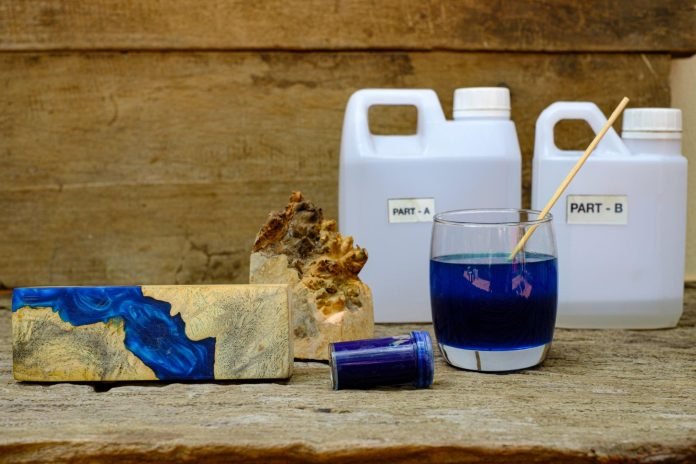When giving new life to old, worn-out items, epoxy has proven to be a versatile and effective tool for DIY enthusiasts and restoration professionals. Epoxy resin provides a strong and durable bond and offers endless possibilities for creativity. However, this comprehensive guide will explore eight techniques to restore and repair old items with epoxy.
Crack and Chip Repair

The most common issues with old items are cracks and chips. Whether it’s a cherished pottery or a vintage wooden chair, epoxy can work wonders. Start by cleaning the damaged area thoroughly. Then, mix epoxy according to the manufacturer’s instructions and apply it to the cracks or chips. Once it cures, sand it down to match the surrounding surface. The result is a seamless and sturdy repair.
Filling Gaps and Voids
Old wooden furniture often has gaps or missing chunks of wood. Epoxy can fill these gaps and restore the item’s structural integrity. Mix a slightly thicker epoxy for this technique and press it into the voids. You can even use tinted epoxy to match the wood’s color. Therefore, after it hardens sand and finish the surface for a smooth and natural look.
Reattaching Loose Joints
Chairs, tables, and other wooden items often suffer from loose joints over time. Epoxy resin is an excellent choice for reattaching these joints securely. First, disassemble the item if necessary. Then, apply epoxy to the joint surfaces and reassemble the piece. The epoxy will create a strong bond, making the item as good as new.
Sealing and Stabilizing Wood
Old wooden items may have areas with rot or instability. Epoxy can effectively stabilize and seal these areas. Stir epoxy with a low-viscosity hardener to ensure it penetrates the wood fibers. Apply the mixture to the affected area, allowing it to soak in. However, the epoxy will harden and create a stable, rot-resistant barrier.
Enhancing and Protecting Surfaces
Sometimes, the goal is to repair, enhance, and protect the existing surface. However, epoxy can provide a glossy, protective finish to items like tabletops, bar counters, and decorative objects. To achieve this, pour a layer of epoxy over the surface and spread it evenly. Allow it to cure for a smooth, glass-like finish that protects and beautifies.
Replacing Missing or Broken Pieces
Older items may have missing or broken parts that are challenging to find replacements for. However, with epoxy resin, you can create custom replacement pieces. Craft a mold that matches the lost or broken part, and then pour epoxy into it. Once it cures, remove it from the mold and sand it to fit perfectly. This technique is particularly useful for decorative pieces or intricate details.
Decorative Inlays and Accents
Epoxy is not just for repairs; it’s a powerful tool for adding decorative elements to old items. You can use epoxy to create colorful inlays, embed objects like shells or coins, or even add intricate designs. Pour a thin layer of epoxy into the desired area, arrange your decorative elements, and pour another layer over them. The result is a stunning, personalized piece.
Refinishing and Restoring Old Jewelry
Old jewelry often loses its luster or may have broken components. Epoxy is perfect for refinishing and restoring these sentimental pieces. Start by cleaning the jewelry thoroughly. Then, apply a thin layer of epoxy to restore the shine and protect the metal. For details with missing stones or broken parts, epoxy can securely reattach or replace these elements.
Reviving Cracked or Chipped Glass
Epoxy isn’t limited to wood and ceramics; it can also work wonders on cracked or chipped glass items. Therefore, begin by cleaning the damaged glass thoroughly. Mix epoxy with a clear hardener, ensuring it has the right viscosity for easy application. Apply the epoxy to the cracked or chipped area, filling in the gaps completely. Once it cures, carefully sand and polish the surface to restore the glass’s clarity and integrity.
Reinforcing and Restoring Fabric and Textiles
For vintage fabric or textiles that have grown fragile or developed tears, epoxy resin offers a viable solution. To begin, gently lay the material flat and stabilize the affected area. Prepare a modest quantity of epoxy and meticulously apply it to the tear or weakened region, ensuring thorough penetration of the fibers. Subsequently, cover the epoxy-applied section with a layer of plastic wrap and use a weight to maintain pressure. Following the curing process, the epoxy will effectively fortify the fabric, significantly enhancing its durability and preserving its historical significance.
Final Words
Epoxy is a remarkable material for restoring and repairing old items, whether they hold sentimental value or are too precious to discard. These eight techniques offer many possibilities for breathing new life into your cherished possessions and antiques. Remember to follow safety guidelines for epoxy resin, including proper ventilation and protective gear. With a little creativity and patience, you can transform old, worn-out items into beautiful, functional pieces that will be enjoyed for years.

